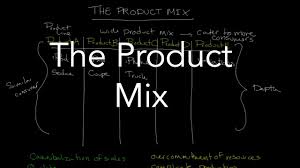Start-up entrepreneurs always brainstorm during the product development phase on the product mix strategies to work with.
This determines if the business will be relevant in the market over time or not.
Therefore, putting these strategies in place from the onset will enhance business growth. As a result, this article has explained the product mix strategies for your business, as well as, its difference with the product line. Stay with us!
What is Product Mix?
Product Mix is also known as product assortment or product portfolio. It refers to the complete set of products or services offered by a company
It consists of product lines which are the items customers use together. For example, milk and milo.
Some companies have product lines within the same product line like liquid soap and washing bars, while others have within different product lines like diapers and hair extensions.
There are four dimensions of a company’s product mix. They are; Width, which shows the number of product lines; Length, which shows the total products in your mix; Depth, which shows product variations; and Consistency, how the product mix are related to each other.
Product Mix Elements
As mentioned earlier, there are four elements of the product mix. We will discuss them in this segment.
#1 Width: Number of Product Lines
The width shows the number of product lines a company sells. For example, if your business deals in business plans and business consulting, your product mix width is two.
Start-ups usually have a narrow or small product mix. As the business expands, they also expand their product lines. And invariably product mix. This is often advised so that the startup can obtain a good market share in its streamlined product lines.
#2 Length: Total Products
The length refers to the number of total products in your product mix. Using the example above, the product line is business plans and past questions. Business plans consist of over 500 business plans like snail farming, baking, fashion, laundry, etc. The same goes for business consulting services like advisory roles, Idea generation, problem-solving, staff training, etc
Do you need a Business Plan? Check our Business Plan Archives
So, the total number of these products makes up the length. Also, companies that have many product lines may keep track of the average length per product line.
#3 Depth: Product Variations
This is the total number of variations for each product.
Variations can include size, flavor, and any other distinguishing characteristic. For example, if your company sells three sizes and two flavors of bread, that bread has a depth of six.
Sometimes, companies can report the average depth of a product line.
#4 Product Mix Consistency: Relationship
Consistency describes how related product lines are in terms of use, production, and distribution. Products may be consistent in production but different in use.
Product mix consistency is an advantage to firms trying to position themselves as niche producer or distributor. In addition, consistency helps improve brand image.
See Also: MASS MARKET: The Ultimate Guide | Business Yield
Difference between Product Mix and a Product line
The product mix is defined as the set of all products a particular seller has for sale. The product mix is also called a product assortment. A product Mix consists of various product lines.
A product line is a set of closely related products that perform similar functions. They often have a similar target market and distribution channels.
See Also: Target Marketing
These variations come about as a need to widen the customer base and attract customers of all spheres of life. Also, they use it to eliminate new market entrants and possible competitors.
For example, Samsung has a product line of mobile phones. But, the phones have different models which range from cheap and affordable phones to expensive ones. (sematext)
These different models of the phone for different classes of customers are known as a product line.
Some attributes of product lines are:
Line Stretching: This occurs when companies increase their products beyond the current range. This can be Downmarket stretch, Upmarket Stretch, and Two-way stretch.
Line filling: Adding more products within the present range. It is more like filling out the missing items so that customers will buy all items from you thereby increasing profit.
For example, a phone shop like Samsung adding earphones, memory cards to their collection. They already did.
Line modernization deals with upgrading to new technologies so that customers will upgrade to higher-priced and valued items.
The line featuring deals with featuring a few products in the line just to attract customers into a showroom where all models will be exposed. This can be likened to a promotion.
Read Also: Promotion Mix: Definition, Types, Importance, & Strategies …
We have to understand that the product line is a subset of the product mix. For example, Samsung offers mobiles, T.V’s, A.C’s, washing machines, etc. Mobiles phones are one product line, T.V is another one. These product lines put together are called a product mix.
Product Mix Examples
One of the examples of product mix is Coca-Cola.
In this post, we will assume that Coca-cola has two product lines which are soft drinks and juice. The classification of soft drinks is Coke, Fanta, Sprite, Diet Coke, Zero coke. And for Juice, we have Guava, Mango, and Mixed fruit.
Now, use the elements of the product mix.
The Width is two: soft drinks and juice.
The length is the total number of products eight.
Depth: Using the example above, there is just one flavor/variation in the products. So, the depth is eight.
Consistency: This will be very high because all the products are beverages. In addition, production and distribution channels remain similar for each product.
The Importance of Product Mix
The product mix of a company is critical to understand since it has a significant impact on the company’s brand image. Maintaining a wide range of products diversifies a product’s product risk and decreases reliance on a single product or product line. However, needless or non-value-added product breadth diversity might harm a brand’s image. For example, if Apple expanded its product line to include refrigerators, it would most likely have a negative influence on its customer brand image.
In terms of a company broadening its product line:
- By broadening the scope, a corporation can better meet the requirements or desires of different consumers while also diversifying risk.
- Increasing the depth can provide the capacity to readdress and better satisfy present customers.
Product Mix Strategies
When companies are starting, it is important, to begin with, a product mix limited in width, depth, and length; and has a high level of consistency. However, over time, the company may want to differentiate products or acquire new ones to enter new markets. They may also add to their lines similar products that are of higher or lower quality to offer different choices and price points.
This is called stretching the product line. When you add higher quality, more expensive products, it’s called upward stretching. If you add lesser quality, lower priced items, it’s called downward stretching.
Product Mix Strategies That Work
The following are the four primary product mix strategies:
- Expansion: This occurs when a corporation increases the number of product lines or the depth (i.e., product varieties) inside those lines.
- Contraction: This occurs when a corporation narrows its product mix in order to eliminate or simplify lower-performing items or lines.
- Changing an Existing Product: Rather of developing an entirely new product, a corporation enhances an existing one.
- Product differentiation: This occurs when a corporation offers a product as a superior alternative to a competing product without altering it in any manner.
Other product mix strategies include:
- Deepening Depth: A corporation maintains existing lines while expanding them.
- Creating New Applications for Existing Products: A corporation discovers and conveys new applications for existing products without disrupting lines or products.
- Trading Up: When a firm adds a higher-priced product to an existing line, it improves the brand image and increases demand for its lower-priced products.
- Trading Down: When a corporation adds a lower-cost product to an existing line of higher-cost products, it is said to be trading down.
Making Use of a Roadmap
A roadmap is a high-level strategic plan that specifies a goal or desired result. It outlines the major stages or milestones required to achieve it. A roadmap also functions as a communication tool, keeping stakeholders informed about all elements of product development.
A roadmap outlines the product’s vision and strategy (i.e., the why.) As a result, a roadmap is critical to the success of a product and should be included in any product mix strategy.
What Is Apple’s Product Mix?
In this scenario, Apple’s product mix includes goods and services that are defined as, or include information technology. However, the corporation continues to diversify its product offering, raising the prospect of including non-IT-related products in this 4P aspect.
What Is Consistency in Product Mix?
The consistency of the product lines relates to how closely connected they are in terms of end-use, production requirements, distribution methods, or any other way.
What Is the Product Mix of Samsung?
Their products are divided into the following categories: Smartphones, such as the Samsung Galaxy series, tablets, wearables, and phone accessories are examples of mobile devices. Samsung Home Appliances include refrigerators, cooking appliances, washing machines, air conditioners, and vacuum cleaners. TV/AV – Samsung Television, Accessories, Audio and Video Accessory
Conclusion
Do you want to scale your business? Do well to follow these product mix strategies for your business to boom. Contact us in the comment box if there are any questions or ideas you’d like to share.






